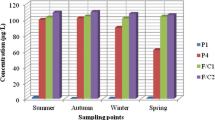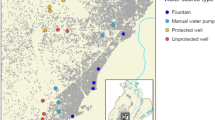Abstract
Two hundred liters of drinking water of the city of Tehran were collected as tap water in a glass container and passed through a XAD-2® resin column at a flow rate of 60–100 ml/minute. The adsorbed materials were eluted with acetone, dried and dissolved in 2 ml dimethylsulfoxide (DMSO). Doses up to 10 μl did not elevate sister chromatid exchanges (SCE) in CHO fibroblasts, while 20 μl caused a significant increase in SCE. However, this dose did not show any chromosomal aberration (CA) in V79 fibroblasts. Doses up to 50 μl of the extract did not increase his + spontaneous revertant colonies in Salmonella typhimurium tester strain TA98, TA100 and TA102 in the absence of S9 metabolizing mixture, neither induced DNA alkaline labile sites in V79 fibroblasts.
Similar content being viewed by others
References
Bellar TA, Lichtenberg JJ, Kroner RC (1974) The occurrence of organohalides in chlorinated drinking water. J Amer Water Works Assoc 66:703–706
Bull RJ, Robinson M, Meier JR, Stober J (1982) Use of biological assay systems to assess the relative carcinogenic hazards of disinfection by-products. Environ Hlth Perspect 46:215–227
Cantor KP, Hoover R, Hartge P, Mason TJ, Silverman DT, Altman R, Austin DF, Child MA, Key CR, Marrett LD, Myers MH, Narayana AS, Levin LT, Sullivan JW, Swanson GM, Thomas DB, West DW (1987) Bladder cancer and drinking water consumption: A case-control study. J Nat Cancer Inst 79:1269–1279
Carrano AV, Thompson LH, Lindl PA, Minkler JL (1978) Sister chromatid exchanges as an indicator of mutagenesis. Nature (Lond) 271:551–553
Dean BJ, Danford N (1984) Assays for the detection of chemically induced chromosomal damage in cultured mammalian cells. In: Venitt S, Parry JM (eds) Mutagenicity testing: A practical approach. IRL Press, Oxford, p 187
Deen DF, Morgan WF, Tofilon P, Barcellos-Hoff MH (1989) Measurement of sister chromatid exchanges and their relationship to DNA damage, repair and cell killing. Pharmac Therap 42:349–360
Durkacz BW, Omidiji O, Gray DA, Shall S (1980) (ADP-ribose)n participates in DNA excision repair. Nature (Lond) 283:593–596
Edelman JR, Lin YJ (1986) Simplified differential staining of mouse sister chromatids. Cytobios 46:147–154
Evans HJ (1982) sister chromatid exchanges and disease states in man. In: Wolff S (ed) Sister chromatid exchanges. John Wiley and Sons, NY, p 183
Farzaneh F, Zalin R, Brill D, Shall S (1982) DNA strand breaks and ADP-ribosyltransferase activation during cell differentiation. Nature (London) 300:362–366
Harris CC (1987) Human tissues and cells in carcinogenesis research. Cancer Res 47:1–10
International Agency for Research on Cancer (1991) Chlorinated drinking water; chlorination by-products; some other halogenated compounds; cobalt and cobalt compounds. IARC Monogr Environ Carcino Risk Human Lyon, 52
Kool HJ, Van Kriji CF, De Greef E, Van Kranen HJ (1982a) Presence, induction and removal of mutagenic activity during the preparation of drinking water in the Netherlands. Environ Hlth Perspect 46:207–214
Kool HJ, Van Kriji CF, Zoeteman BCJ (1982b) Toxicity assessment of organic compounds in drinking water. CRC Crit Rev Environ Control 12:307–357
Kool HJ, Van Kriji CF (1984) Formation and removal mutagenic during drinking water preparation. Water Res 18:1011–1016
Latt SA, Allen J, Bloom SE, Carrano A, Falke E, Kram D, Schneider E, Schreck R, Tice R, Whitefield B, Wolff S (1981) Sister chromatid exchanges: A report of the Gene-tox Program. Mutat Res 87:17–62
Li Y, Zhang W, Noblitt TW, Dunipace AJ, Stooket GK (1989) Genotoxic evaluation of chronic fluoride exposure, sister chromatid exchange study. Mutat Res 227:159–165
Maron DM, Ames BN (1983) Revised methods for the Salmonella mutagenicity test. Mutat Res 113:173–215
Meier J (1990) Mutagens in chlorinated water. Mutation and the Environment Part E, Wiley-Liss, NY p 11
Perry P, Evans HJ (1975) Cytological detection of mutagen-carcinogen exposure by sister chromatid exchanges. Nature (London) 258:121–125
Perry P, Henderson L, Kirkland D (1984) Sister chromatid exchange in cultured cells. In: Dean BJ (ed) Report of the UKEMS sub-committee on guidelines for mutagenicity testing, Part II United Kingdom Environmental Society, United Kingdom, p 89
Pieterse MJ (1988) The potential health risk of trihalomethanes in drinking water, Perspective. South Afr J Sci 84:166–170
Rook JJ (1974) Formation of haloform during chlorination of natural waters. J Soc Water Treat Exam 23:234–243
Sideris EG, Charalambous SC, Tsolomyty A, Katsaros N (1988) Mutagenesis, carcinogenesis and the metal elements-DNA interaction. In: Trifiates GP, Prassad KN (eds) Nutrition, growth and cancer. Progress in Clinical and Biological Research, AR Liss, NY, p 13
Thomas RD (1989) Epidemiological and toxicology of volatile organic chemical contaminants in water absorbed through the skin. J Amer Coll Toxicol 8:779–795
Varga CS (1988) Chlorinated drinking water XAD isolates do not affect the sister chromatid exchange frequency. Int Arch Occup Environ Health 61:147–149
Velema JP (1987) Contaminated drinking water as potential cause of cancer in humans. Environmental carcinogen reviews, J Environ Sci Health C5(1):1–28
Wilcox P, Williamson S (1986) Mutagenic activity of concentrated drinking water samples. Environ Hlth Perspect 69:141–149
Wilcox P, Williamson S, Lodge DC, Bootman J (1988) Concentrated drinking water extracts, which cause bacterial mutation and chromosome damage in CHO cells, do not induce sex-linked recessive lethal mutations in Drosophilla. Mutagen 3:381–387
Wolff S, Perry P (1974) Differential staining sister chromatid and study of sister chromatid exchange without autoradiography. Chromosoma 48:341–353
Yamada K, Hanooka H, Yamada M (1985) Effect of aphidicoline and/or 2′,3′-dideoxythymidine on DNA repair induced in HeLa cells by four types of DNA-damaging agents. J Biol Chem 260:10412–10417
Yamasaki E, Ames BN (1977) Concentration of mutagens from urine by adsorption with the nonpolar resin XAD-2: Cigarette smokers have mutagenic urine. Proc Nat Acad Sci USA 74:3555–3559
Zoeteman BCJ, Hrubec J, DeGreef J, Kool HJ (1982) Mutagenic activity associated with by-products of drinking water disinfection by chlorine, chlorine dioxide, ozone and UV-irradiation. Environ Hlth Perspect 46:197–205
Author information
Authors and Affiliations
Rights and permissions
About this article
Cite this article
Sabouni, F., Zia'ee, A.A. Genotoxic risk assessment of drinking water consumed in the city of Tehran, Iran. Arch. Environ. Contam. Toxicol. 28, 391–395 (1995). https://doi.org/10.1007/BF00213118
Received:
Revised:
Issue Date:
DOI: https://doi.org/10.1007/BF00213118




